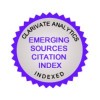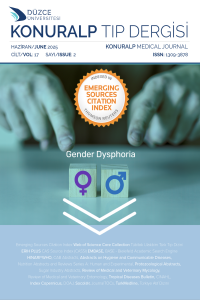Ulusal ve Uluslararası Afet Risk Azaltma Planlarında Bulaşıcı Salgın Hastalıklar: Türkiye Afet Risk Azaltma Planı (TARAP) ve Uluslararası Politika Belgeleri Bağlamında Bir Analiz
Öz
Amaç: Çalışmanın amacı, bulaşıcı salgın hastalıkların ulusal ve uluslararası afet risk azaltma stratejilerine nasıl entegre edildiğini karşılaştırmalı olarak değerlendirmektir. Türkiye’nin Afet Risk Azaltma Planının (TARAP), benzer politika ve strateji belgeleriyle karşılaştırılarak güçlü yönlerin, geliştirilmesi gereken alanların ortaya çıkarılması hedeflenmektedir. Uluslararası politika çerçeveleriyle Türkiye’nin uyumu ve farklılıklarını ortaya koyarak afet ve sağlık yönetimi arasındaki ilişkiye dair kapsamlı bir analiz yapılmıştır.
Yöntem: Çalışma karşılaştırmalı nitel analize dayanmaktadır. Planlar, tematik kodlama yöntemi
kullanılarak dört temel başlık altında değerlendirilmiştir: yönetişim ve kurumsal yapı, erken uyarı ve dijital izleme sistemleri, toplumsal farkındalık ve eğitim politikaları ile finansal kaynak ve operasyonel hazırlık düzeyleri.
Bulgular: Karşılaştırmalı analiz, bulaşıcı salgın hastalıkların entegrasyonu açısından TARAP’ın diğer ülkelerin ulusal afet risk azaltma stratejileriyle arasında benzerlikler ve farklılıklar olduğunu ortaya koymuştur. İncelenen ülkelerde, sağlık sistemi dayanıklılığının artırılması, erken uyarı ve epidemiyolojik izleme mekanizmalarının güçlendirilmesi, kamuoyu farkındalığının artırılması, sektörler arası iş birliğinin teşvik edilmesi gibi stratejik önceliklere vurgu yapılmaktadır. Özellikle COVID-19 pandemisi sonrasında ülkeler, salgın hastalıkları afet politikalarının merkezine yerleştirmiş; dijital epidemiyolojik gözetim sistemlerine, etkili risk iletişim stratejilerine öncelik vermiştir. TARAP, salgın hastalıkları afet türü olarak sınıflandırarak uluslararası eğilimlerle uyum göstermektedir. Ancak afet sonrası dijital erken uyarı sistemlerinin uygulanması ve operasyonel kaynak tahsisinde ayrıntılı planlamanın eksikliği sürmektedir.
Sonuç: Bulaşıcı hastalıkların afet politikalarına entegrasyonu, güçlü sağlık sistemleri, etkin halk sağlığı eğitimi ve dijital altyapı yatırımlarını kapsayan çok sektörlü, bütüncül yaklaşımlar gerektirmektedir. TARAP, salgın hastalık risklerinin yönetiminde başlangıç noktası oluştursa da dijital izleme, finansal planlama ve paydaş koordinasyonu alanlarında geliştirilmesi gerekmektedir.
Anahtar Kelimeler
TARAP Bulaşıcı Hastalıklar Afet Risk Azaltma Sağlık Sistemi Dirençliliği Afet Politikası
Kaynakça
- 1. Afet ve Acil Durum Yönetimi Başkanlığı (AFAD) [Internet]. Açıklamalı Afet Yönetimi Terimleri Sözlüğü, 2022 [cited 2025 Apr 2]. Available from: [https://www.afad.gov.tr/aciklamali-afet-yonetimi-terimleri-sozlugu]
- 2. Abid SK, Sulaiman N, Chan SW, Nazir U, Abid M, Han H, Ariza-Montes A, Vega-Muñoz A. Toward an Integrated Disaster Management Approach: How Artificial Intelligence Can Boost Disaster Management. Sustainability. 2021;13(22):12560.
- 3. Pascapurnama DN, Murakami A, Chagan-Yasutan H, Hattori T, Sasaki H, & Egawa S. Integrated health education in disaster risk reduction: Lesson learned from disease outbreak following natural disasters in Indonesia. International Journal of Disaster Risk Reduction. 2018;29:94-102.
- 4. Kouadio IK, Aljunid S, Kamigaki T, Hammad K, Oshitani H. Infectious diseases following natural disasters: prevention and control measures. Expert Rev Anti Infect Ther. 2012;10(1):95-104.
- 5. Watson JT, Gayer M, Connolly MA. Epidemics after natural disasters. Emerg Infect Dis. 2007;13(1):1-5.
- 6. Allworth A. Infectious disease considerations related to sudden flooding disasters for the emergency physician. Emerg Med Australas. 2011;23(2):120-2.
- 7. Ivers LC, Ryan ET. Infectious diseases of severe weather-related and flood-related natural disasters. Curr Opin Infect Dis. 2006;19(5):408-14.
- 8. Lemonick DM, Epidemics After Natural Disasters. American Journal of Clinical Medicine, Fall 2011;8(3):144-152.
- 9. Liang SY, Messenger N. Infectious Diseases After Hydrologic Disasters. Emerg Med Clin North Am. 2018;36(4):835-51.
- 10. Makwana N. Public health care system's preparedness to combat epidemics after natural disasters. J Family Med Prim Care. 2020;9(10):5107-2.
- 11. Noji EK. The Nature of Disasters. In: Noji EK editor. The Public Health Consequences of Disaster. New York: Oxford University Press; 1997. p. 3-21.
- 12. Baran A, Özer A. Prevention of Infectious Diseases after an Earthquake. Cam and Sakura Med J. 2023;3(1):42-7.
- 13. Ahmad B, Murray V. Disaster risk reduction and sustainable development: the role for occupational health. Occup Med (Lond). 2018;68(7):422-4.
- 14. Bang, H. Sustainable development goals, disaster risk management, and indigenous knowledge: a critical assessment of the interlinkages. Sustain Earth Reviews. 2024;7:29.
- 15. Di Marco M, Baker ML, Daszak P, De Barro P, Eskew EA, Godde CM, Harwood TD, Herrero M, Hoskins AJ, Johnson E, Karesh WB, Machalaba C, Garcia JN, Paini D, Pirzl R, Smith MS, Zambrana-Torrelio C, Ferrier S. Opinion: Sustainable development must account for pandemic risk. Proc Natl Acad Sci U S A. 2020;117(8):3888-92.
- 16. Qazi A, Angell LC, Simsekler MCE, Daghfous A, Al-Mhdawi MKS. Assessing the Impact of Sustainability Risks on Disaster and Pandemic Vulnerabilities: A Global Perspective. Global Transitions. 2025 Mar 13. Advance online publication. doi: 10.1016/j.glt.2025.03.001
- 17. Palmeiro-Silva Y, Rivera F, Hartinger S. Climate Change and Health Within the Sendai Framework for Disaster Risk Reduction: Opportunities and Challenges. Int J Disaster Risk Sci. 2025;16:33–43.
- 18. UNDRR. Sendai Framework for Disaster Risk Reduction 2015–2030. [Internet]. United Nations Office for Disaster Risk Reduction. [cited 2025 Apr 2]. Available from: https://www.unisdr.org/files/43291_sendaiframeworkfordrren.pdf
- 19. WHO, Health Emergency and Disaster Risk Management Framework. [Internet]. World Health Organization. 2019 [cited 2025 Apr 2]. Available from: https://iris.who.int/bitstream/handle/10665/326106/9789241516181-eng.pdf
- 20. Aitsi-Selmi, A., Egawa, S., Sasaki, H. et al. The Sendai Framework for Disaster Risk Reduction: Renewing the Global Commitment to People’s Resilience, Health, and Well-being. Int J Disaster Risk Sci. 2015;6:164–76.
- 21. Busayo ET, Kalumba AM, Afuye GA, Ekundayo OY, Orimoloye IR. Assessment of the Sendai framework for disaster risk reduction studies since 2015. International Journal of Disaster Risk Reduction. 2020;50:101906.
- 22. Mohapatra S, Menon NG. Factors responsible for the emergence of novel viruses: An emphasis on SARS-CoV-2. Current Opinion in Environmental Science & Health. 2022;27:100358.
- 23. Djalante R, Shaw R, DeWit A. Building resilience against biological hazards and pandemics: COVID-19 and its implications for the Sendai Framework. Progress in Disaster Science. 2020;6:100080.
- 24. Ceylan, S. COVID-19 Pandemisinde Sağlık Sistemleri: Japonya Örneği. Toplum ve Hekim. 2021;36:4.
- 25. Katsuda N, Hinohara Y, Tomita K, Hamajima N. Structure and roles of public health centers (hokenjo) in Japan. Nagoya Journal of Medical Science. 2011;73:1-2:59-68.
- 26. Ministry of Health, Labour and Welfare (Japan). Global health vision of Ministry of Health, Labour and Welfare of Japan [Internet]. Tokyo: Ministry of Health, Labour and Welfare; 2024 Aug 26 [cited 2025 Mar 10]. 26 p. Available from: https://www.mhlw.go.jp/content/10501000/001295190.pdf.
- 27. Zhang X, Oyama T. Investigating the health care delivery system in Japan and reviewing the local public hospital reform. Risk Management Health Policy. 2016;9:21-32.
- 28. Ikeda, M. Experience from Japan, Best practices, Technologies and capacity development tools for earthquake risk reduction from Japan; 2 August 2023; CJK Education and Training Institutes Online Workshop “Tools and Technologies for Earthquake Risk Management: Sharing Experience from Northeast Asia”; 2023.
- 29. CDC, 2022. CDC Strategy for Global Response to COVID-19 (2020-2023) [Internet]. U.S. Center For Disease Control and Prevention Office. [cited 2025 March 9] Available from: www.cdc.gov/coronavirus/2019-ncov/global-covid-19.
- 30. Safe Work Australia. National hazard exposure worker surveillance – exposure to biological hazards and the provision of controls against biological hazards in Australian workplaces [Internet]. Australian Safety and Compensation Council (ASCC); 2011 Mar [cited 2025 Feb 21]. 25 p. Available from: https://www.safeworkaustralia.gov.au/system/files/documents/1702/nhews_biologicalmaterials.pdf. ISBN: 978-0-642-33164-9.
- 31. Australian Institute for Disaster Resilience. Australian emergency management arrangements [Internet]. Australian Government National Emergency Management Agency; 2023 [cited 2025 Feb 14]. 28 p. Available from: https://knowledge.aidr.org.au/media/10162/handbook_aema_web_2023.pdf. ISBN: 978-0-6457560-0-5.
- 32. Federal Office of Civil Protection and Disaster Assistance (BBK). Germany Guide for emergency preparedness and correct action in emergency situations [Internet]. Disaster Alarm. 2018 [cited 2025 Mar 22]. Available from:https://www.bbk.bund.de/ SharedDocs/Downloads/EN/Mediathek/Publikationen/ratgeber-englisch-disasters-alarm.pdf?__blob=publicationFile. ISBN: 978-3-939347-54-5.
- 33. Robert Koch Institute. The Robert Koch Institute flyer [Internet]. Berlin: Robert Koch Institute; [cited 2025 March 9]. Available from: https://www.rki.de/EN/Home/ home_node.html.
- 34. The Robert Koch Institute Mission. [Internet]. Germany: [cited 2025 March 15] Available from: https://www.rki.de/EN/Institute/The-RKI/ Mission-statement/ mission-statement-node.html.
- 35. Canada Ministry of Health. Canadian emergency management guideline [Internet]. Ottawa: Canada Ministry of Health; 2024 Feb. [cited 2025 Mar 20]. Available from: https://www.canada.ca/en/health-canada/services/emergency-management-guideline.html. ISBN:978-1-4868-7720-1.
- 36. Türkiye Afet Risk Azaltma Planı, TARAP [Internet]. Ankara: AFAD; 2022 [cited 2025 March 1]. Available from: https://www.afad.gov.tr/kurumlar/afad.gov.tr/ e_Kutuphane/Planlar/28032022-TARAP-kitap_V6.pdf. AFAD 2022
- 37. The United Nations Department of Economic and Social Affairs Sustainable Development. [Internet]. [cited 2025 March 18]. Available from: https://sdgs.un.org/goals, https://sdgs.un.org/2030agenda
- 38. IPCC Sixth Assessment Report. Intergovernmental Panel on Climate Change. [Internet]. 2021, [cited 2025 March 5]. Available from: https://www.ipcc.ch/assessment-report/ar6/
- 39. UN-Water. Water and Health Report. [Internet]. 2021, [cited 2025 March 5]. Available from: https://unsceb.org/sites/default/files/2022-10/Annual-Report-2021_30June2022.pdf
- 40. UN-Habitat World Cities Report: Urban Resilience and Sustainability. [Internet]. 2022, [cited 2025 March 5]. Available from: https://unhabitat.org/sites/default/files/2022/06/wcr_2022.pdf
Infectious Epidemic Diseases in National and International Disaster Risk Reduction Strategies: A Comparative Analysis of Türkiye's Disaster Risk Reduction Plan (TARAP) and International Policy Frameworks
Öz
Objective: This study aims to evaluate how infectious epidemics are integrated into national and international disaster risk reduction strategies comparatively. It aims to compare Türkiye's Disaster Risk Reduction Plan (TARAP) with similar policy and strategy documents to reveal strengths and areas for development. A comprehensive analysis of the relationship between disaster and health management revealed Türkiye's compliance and differences with international policy frameworks.
Method: The study is based on qualitative comparative analysis. The plans were evaluated under four main headings using a thematic coding method: governance and institutional structure, early warning and digital monitoring systems, public awareness and education policies, and financial resources and operational preparedness levels.
Results: The comparative analysis revealed that TARAP has similarities and differences with other countries national disaster risk reduction strategies regarding integrating infectious epidemics. In the countries examined, strategic priorities such as increasing health system resilience, strengthening early warning and epidemiological monitoring mechanisms, increasing public awareness, and encouraging intersectoral cooperation are emphasized. Especially after the COVID-19 pandemic, countries have placed epidemics at the center of their disaster policies; they have prioritized digital epidemiological surveillance systems and effective risk communication strategies. TARAP aligns with international trends by classifying epidemics as a type of disaster. However, the lack of detailed planning in implementing post-disaster digital early warning systems and operational resource allocation continues.
Conclusions: Integrating infectious diseases into disaster policies requires multi-sectoral, holistic approaches that include strong health systems, effective public health education, and digital infrastructure investments. Although TARAP is a starting point in managing epidemic risks, it must be developed in digital monitoring, financial planning, and stakeholder coordination
Anahtar Kelimeler
TARAP Infectious Diseases Disaster Risk Reduction Health System Resilience Disaster Policy
Kaynakça
- 1. Afet ve Acil Durum Yönetimi Başkanlığı (AFAD) [Internet]. Açıklamalı Afet Yönetimi Terimleri Sözlüğü, 2022 [cited 2025 Apr 2]. Available from: [https://www.afad.gov.tr/aciklamali-afet-yonetimi-terimleri-sozlugu]
- 2. Abid SK, Sulaiman N, Chan SW, Nazir U, Abid M, Han H, Ariza-Montes A, Vega-Muñoz A. Toward an Integrated Disaster Management Approach: How Artificial Intelligence Can Boost Disaster Management. Sustainability. 2021;13(22):12560.
- 3. Pascapurnama DN, Murakami A, Chagan-Yasutan H, Hattori T, Sasaki H, & Egawa S. Integrated health education in disaster risk reduction: Lesson learned from disease outbreak following natural disasters in Indonesia. International Journal of Disaster Risk Reduction. 2018;29:94-102.
- 4. Kouadio IK, Aljunid S, Kamigaki T, Hammad K, Oshitani H. Infectious diseases following natural disasters: prevention and control measures. Expert Rev Anti Infect Ther. 2012;10(1):95-104.
- 5. Watson JT, Gayer M, Connolly MA. Epidemics after natural disasters. Emerg Infect Dis. 2007;13(1):1-5.
- 6. Allworth A. Infectious disease considerations related to sudden flooding disasters for the emergency physician. Emerg Med Australas. 2011;23(2):120-2.
- 7. Ivers LC, Ryan ET. Infectious diseases of severe weather-related and flood-related natural disasters. Curr Opin Infect Dis. 2006;19(5):408-14.
- 8. Lemonick DM, Epidemics After Natural Disasters. American Journal of Clinical Medicine, Fall 2011;8(3):144-152.
- 9. Liang SY, Messenger N. Infectious Diseases After Hydrologic Disasters. Emerg Med Clin North Am. 2018;36(4):835-51.
- 10. Makwana N. Public health care system's preparedness to combat epidemics after natural disasters. J Family Med Prim Care. 2020;9(10):5107-2.
- 11. Noji EK. The Nature of Disasters. In: Noji EK editor. The Public Health Consequences of Disaster. New York: Oxford University Press; 1997. p. 3-21.
- 12. Baran A, Özer A. Prevention of Infectious Diseases after an Earthquake. Cam and Sakura Med J. 2023;3(1):42-7.
- 13. Ahmad B, Murray V. Disaster risk reduction and sustainable development: the role for occupational health. Occup Med (Lond). 2018;68(7):422-4.
- 14. Bang, H. Sustainable development goals, disaster risk management, and indigenous knowledge: a critical assessment of the interlinkages. Sustain Earth Reviews. 2024;7:29.
- 15. Di Marco M, Baker ML, Daszak P, De Barro P, Eskew EA, Godde CM, Harwood TD, Herrero M, Hoskins AJ, Johnson E, Karesh WB, Machalaba C, Garcia JN, Paini D, Pirzl R, Smith MS, Zambrana-Torrelio C, Ferrier S. Opinion: Sustainable development must account for pandemic risk. Proc Natl Acad Sci U S A. 2020;117(8):3888-92.
- 16. Qazi A, Angell LC, Simsekler MCE, Daghfous A, Al-Mhdawi MKS. Assessing the Impact of Sustainability Risks on Disaster and Pandemic Vulnerabilities: A Global Perspective. Global Transitions. 2025 Mar 13. Advance online publication. doi: 10.1016/j.glt.2025.03.001
- 17. Palmeiro-Silva Y, Rivera F, Hartinger S. Climate Change and Health Within the Sendai Framework for Disaster Risk Reduction: Opportunities and Challenges. Int J Disaster Risk Sci. 2025;16:33–43.
- 18. UNDRR. Sendai Framework for Disaster Risk Reduction 2015–2030. [Internet]. United Nations Office for Disaster Risk Reduction. [cited 2025 Apr 2]. Available from: https://www.unisdr.org/files/43291_sendaiframeworkfordrren.pdf
- 19. WHO, Health Emergency and Disaster Risk Management Framework. [Internet]. World Health Organization. 2019 [cited 2025 Apr 2]. Available from: https://iris.who.int/bitstream/handle/10665/326106/9789241516181-eng.pdf
- 20. Aitsi-Selmi, A., Egawa, S., Sasaki, H. et al. The Sendai Framework for Disaster Risk Reduction: Renewing the Global Commitment to People’s Resilience, Health, and Well-being. Int J Disaster Risk Sci. 2015;6:164–76.
- 21. Busayo ET, Kalumba AM, Afuye GA, Ekundayo OY, Orimoloye IR. Assessment of the Sendai framework for disaster risk reduction studies since 2015. International Journal of Disaster Risk Reduction. 2020;50:101906.
- 22. Mohapatra S, Menon NG. Factors responsible for the emergence of novel viruses: An emphasis on SARS-CoV-2. Current Opinion in Environmental Science & Health. 2022;27:100358.
- 23. Djalante R, Shaw R, DeWit A. Building resilience against biological hazards and pandemics: COVID-19 and its implications for the Sendai Framework. Progress in Disaster Science. 2020;6:100080.
- 24. Ceylan, S. COVID-19 Pandemisinde Sağlık Sistemleri: Japonya Örneği. Toplum ve Hekim. 2021;36:4.
- 25. Katsuda N, Hinohara Y, Tomita K, Hamajima N. Structure and roles of public health centers (hokenjo) in Japan. Nagoya Journal of Medical Science. 2011;73:1-2:59-68.
- 26. Ministry of Health, Labour and Welfare (Japan). Global health vision of Ministry of Health, Labour and Welfare of Japan [Internet]. Tokyo: Ministry of Health, Labour and Welfare; 2024 Aug 26 [cited 2025 Mar 10]. 26 p. Available from: https://www.mhlw.go.jp/content/10501000/001295190.pdf.
- 27. Zhang X, Oyama T. Investigating the health care delivery system in Japan and reviewing the local public hospital reform. Risk Management Health Policy. 2016;9:21-32.
- 28. Ikeda, M. Experience from Japan, Best practices, Technologies and capacity development tools for earthquake risk reduction from Japan; 2 August 2023; CJK Education and Training Institutes Online Workshop “Tools and Technologies for Earthquake Risk Management: Sharing Experience from Northeast Asia”; 2023.
- 29. CDC, 2022. CDC Strategy for Global Response to COVID-19 (2020-2023) [Internet]. U.S. Center For Disease Control and Prevention Office. [cited 2025 March 9] Available from: www.cdc.gov/coronavirus/2019-ncov/global-covid-19.
- 30. Safe Work Australia. National hazard exposure worker surveillance – exposure to biological hazards and the provision of controls against biological hazards in Australian workplaces [Internet]. Australian Safety and Compensation Council (ASCC); 2011 Mar [cited 2025 Feb 21]. 25 p. Available from: https://www.safeworkaustralia.gov.au/system/files/documents/1702/nhews_biologicalmaterials.pdf. ISBN: 978-0-642-33164-9.
- 31. Australian Institute for Disaster Resilience. Australian emergency management arrangements [Internet]. Australian Government National Emergency Management Agency; 2023 [cited 2025 Feb 14]. 28 p. Available from: https://knowledge.aidr.org.au/media/10162/handbook_aema_web_2023.pdf. ISBN: 978-0-6457560-0-5.
- 32. Federal Office of Civil Protection and Disaster Assistance (BBK). Germany Guide for emergency preparedness and correct action in emergency situations [Internet]. Disaster Alarm. 2018 [cited 2025 Mar 22]. Available from:https://www.bbk.bund.de/ SharedDocs/Downloads/EN/Mediathek/Publikationen/ratgeber-englisch-disasters-alarm.pdf?__blob=publicationFile. ISBN: 978-3-939347-54-5.
- 33. Robert Koch Institute. The Robert Koch Institute flyer [Internet]. Berlin: Robert Koch Institute; [cited 2025 March 9]. Available from: https://www.rki.de/EN/Home/ home_node.html.
- 34. The Robert Koch Institute Mission. [Internet]. Germany: [cited 2025 March 15] Available from: https://www.rki.de/EN/Institute/The-RKI/ Mission-statement/ mission-statement-node.html.
- 35. Canada Ministry of Health. Canadian emergency management guideline [Internet]. Ottawa: Canada Ministry of Health; 2024 Feb. [cited 2025 Mar 20]. Available from: https://www.canada.ca/en/health-canada/services/emergency-management-guideline.html. ISBN:978-1-4868-7720-1.
- 36. Türkiye Afet Risk Azaltma Planı, TARAP [Internet]. Ankara: AFAD; 2022 [cited 2025 March 1]. Available from: https://www.afad.gov.tr/kurumlar/afad.gov.tr/ e_Kutuphane/Planlar/28032022-TARAP-kitap_V6.pdf. AFAD 2022
- 37. The United Nations Department of Economic and Social Affairs Sustainable Development. [Internet]. [cited 2025 March 18]. Available from: https://sdgs.un.org/goals, https://sdgs.un.org/2030agenda
- 38. IPCC Sixth Assessment Report. Intergovernmental Panel on Climate Change. [Internet]. 2021, [cited 2025 March 5]. Available from: https://www.ipcc.ch/assessment-report/ar6/
- 39. UN-Water. Water and Health Report. [Internet]. 2021, [cited 2025 March 5]. Available from: https://unsceb.org/sites/default/files/2022-10/Annual-Report-2021_30June2022.pdf
- 40. UN-Habitat World Cities Report: Urban Resilience and Sustainability. [Internet]. 2022, [cited 2025 March 5]. Available from: https://unhabitat.org/sites/default/files/2022/06/wcr_2022.pdf
Ayrıntılar
| Birincil Dil | İngilizce |
|---|---|
| Konular | Sağlık Hizmetleri ve Sistemleri (Diğer) |
| Bölüm | Makaleler |
| Yazarlar | |
| Yayımlanma Tarihi | 17 Haziran 2025 |
| Gönderilme Tarihi | 7 Nisan 2025 |
| Kabul Tarihi | 10 Haziran 2025 |
| Yayımlandığı Sayı | Yıl 2025 Cilt: 17 Sayı: 2 |
Kaynak Göster





